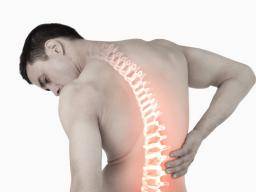Inversion therapy is said to take the pressure off a person's spine, open up the vertebrae, and increase circulation. However, evidence of its effectiveness is mixed, and it may not be safe for everyone, such as those with high blood pressure or glaucoma.
The 2017 clinical guidelines from the American College of Physicians (ACP) state that, while inversion and other traction therapies do not appear harmful in otherwise healthy people, there is little good-quality evidence for their effectiveness over other techniques.
In this article, we look at how inversion therapy works and the possible benefits and risks of this treatment.
How does inversion therapy work?

Inversion therapy involves being suspended upside down, sometimes with the help of equipment.
The theory behind inversion therapy says that by inverting a person so that their feet are above their head, it is possible to reverse the effect of gravity on the body. Gravity causes muscles, joints, and bones of the back to compress the spine over time, contributing to chronic back pain.
Inversion therapy is thought to decompress the spine, much like gentle massage or physical manipulation, and could allow people to find some relief from symptoms such as chronic back pain.
Inversion therapy must always be done under a doctor's supervision.
Types of inversion therapy
Inversion therapy requires special equipment, such as specialized chairs, tables, or gravity boots. However, a person can also practice inversion therapy without equipment by doing certain yoga poses and exercises.
Equipment
Inversion equipment is relatively inexpensive depending on the brand and build quality. However, most insurance companies will not cover the cost of alternative therapies.
Inversion equipment includes:
Inversion tables. Swiveling tables that enable a person to hang securely upside down with their back resting on a bed. This position mimics the standing position, only upside down. Inversion tables are available to buy online.
Inversion chairs. A person sits in the chair and straps themselves in before being turned upside down. Some people think that this sitting position is more beneficial, as it puts less pressure on the leg joints.
Gravity boots. Gravity boots are fundamentally sturdy ankle boots that allow a person to hang upside down by their feet. They provide more freedom and maneuverability than other inversion equipment. There are many types of gravity boots available from online stores.
Alternative methods
Yoga instructors may recommend inversion postures to help relieve pressure on the back. Postures include headstands, shoulder stands, and poses such as the Dolphin or Plow.
These are advanced postures that should always be done under the supervision of a trained yoga instructor.
Potential benefits of inversion therapy
According to the 2017 clinical guidelines from the ACP, the evidence for the benefits of traction therapies, including inversion therapy, is not conclusive.
However, some people who practice inversion therapy themselves or offer the service in their clinical practice, find there are a few potential benefits to making a habit out of inversion.
Improve spinal health

Inversion therapy is often used to treat back pain and spinal problems.
Gravity puts pressure on the spine and muscles in the back that keep the body upright, causing the spine to compress over time.
Physical manipulation of the spine, massage, and muscle-strengthening techniques are often used to release compression. Holding the body upside down might stretch the spine in a similar way to these techniques.
Using inversion equipment or doing specific yoga poses every day may improve the overall health of the spine and ligaments and reduce pressure on the muscles in the area.
Ultimately, this could translate to more comfortable movements and a more open and flexible body.
Reduce chronic back pain
Many people who use inversion therapy to relieve chronic back pain are looking for a gentle, non-invasive way to treat their pain. Inversion therapy may ease the pressure on weight-bearing joints and allow them to rest and recuperate.
The decompressing effects of inversion therapy could potentially help with many sources of back pain, such as disc or joint pain. Decompression may also reduce the intensity of any muscle spasms in the back.

Avoid surgery
A 2012 second study published in Disability and Rehabilitation, found that using an inversion device reduced the need for surgery in some people with lumbar discogenic disease, which is a condition that causes the discs in the back to become thin and weak. However, this study only looked at 26 people, so more research is needed.
A person should always listen to the advice of their doctor or chiropractor about the best treatments for their specific back problems.
Risks of inversion therapy

Those with certain eye conditions should avoid inversion therapy.
Hanging upside down decreases the heart rate while increasing blood pressure and can put pressure on the eyeballs and inner ear.
Because of this, inversion therapy is not recommended for people with:
high blood pressure
history of stroke
osteoporosis
a hernia
broken bones

Thanks for your insight for your fantastic posting. I’m exhilarated I have taken the time to see this. It is not enough; I will visit your site every day. best inversion table for lower back pain
ReplyDelete